The agricultural industry is facing a significant challenge with the recent bird flu outbreaks affecting cows, which has sparked concerns about the impact on livestock health and dairy production. In response, researchers and farmers are exploring innovative solutions to manage and prevent the spread of this disease. Stopping the bird flu outbreak in cows: A new approach beyond milk is essential to ensuring the stability of the agricultural sector and protecting animal health. This blog delves into the new strategies being developed to tackle this issue and their potential impact on the industry.
Understanding the Problem
Bird flu, or avian influenza, is primarily a disease affecting birds, but it can also pose risks to other animals, including cows. While bird flu outbreaks in poultry have been well-documented, recent incidents have shown that the virus can cross species barriers and infect cattle. This has raised alarms about the potential for widespread outbreaks and the impact on dairy production.
Traditionally, managing bird flu in cows has involved measures related to milk safety, such as testing and monitoring for contamination. However, these methods alone may not be sufficient to address the broader issue of disease prevention and control. This is where stopping the bird flu outbreak in cows: A new approach beyond milk comes into play.
Innovative Approaches to Disease Control
Stopping the bird flu outbreak in cows: A new approach beyond milk requires a multifaceted strategy that goes beyond traditional dairy-related measures. Researchers and agricultural experts are exploring several innovative methods to manage and prevent the spread of bird flu among cattle:
Enhanced Biosecurity Measures:
Implementing stricter biosecurity protocols on farms can significantly reduce the risk of bird flu transmission. This includes controlling access to livestock areas, disinfecting equipment, and monitoring for signs of illness. Farms are also adopting measures to prevent contact between birds and cattle, which can help minimize the risk of cross-species transmission.
Vaccination and Immunization:
Developing effective vaccines for bird flu in cows is a key focus of ongoing research. Vaccination programs aimed at preventing the spread of the virus can be instrumental in controlling outbreaks. Researchers are working on creating vaccines that are specifically designed for cattle and evaluating their effectiveness in real-world conditions.
Surveillance and Early Detection:
Implementing advanced surveillance systems can help detect bird flu outbreaks early and enable timely intervention. These systems use technology such as remote sensors and data analytics to monitor livestock health and identify potential outbreaks before they become widespread.
Cross-Species Research:
Understanding how bird flu viruses interact with different species is crucial for developing effective control measures. Researchers are studying how the virus affects cows and identifying potential pathways for transmission. This research helps in designing targeted interventions and improving disease management strategies.
The Role of Technology and Innovation
Stopping the bird flu outbreak in cows: A new approach beyond milk involves leveraging technology and innovation to enhance disease control efforts. For example, advanced diagnostic tools and genetic analysis can provide insights into the virus’s behavior and its impact on cattle. Technology-driven solutions such as automated monitoring systems and data-driven decision-making can improve the efficiency of disease management practices.
Furthermore, collaboration between researchers, farmers, and agricultural organizations is essential for implementing new strategies and sharing knowledge. By working together, stakeholders can develop and deploy effective solutions to combat bird flu outbreaks and protect livestock health.
Implications for the Agricultural Industry
The implementation of new approaches to stopping bird flu outbreaks in cows has significant implications for the agricultural industry. Improved disease control measures can lead to increased stability in dairy production, reduced economic losses, and enhanced animal welfare. Additionally, addressing bird flu effectively helps maintain consumer confidence in dairy products and ensures the safety of the food supply.
As researchers continue to develop and refine these innovative strategies, the focus remains on creating sustainable solutions that address the root causes of bird flu outbreaks. By moving beyond traditional methods and embracing new technologies, the agricultural industry can better manage and prevent the spread of this disease.
Conclusion
Stopping the bird flu outbreak in cows: A new approach beyond milk is crucial for tackling the challenges posed by this emerging threat to livestock health. By implementing enhanced biosecurity measures, investing in vaccination research, and leveraging technology, the agricultural industry can improve its response to bird flu outbreaks and safeguard dairy production. As the industry adapts to these new strategies, it is poised to create a more resilient and effective approach to managing animal health and preventing disease.




Leave feedback about this